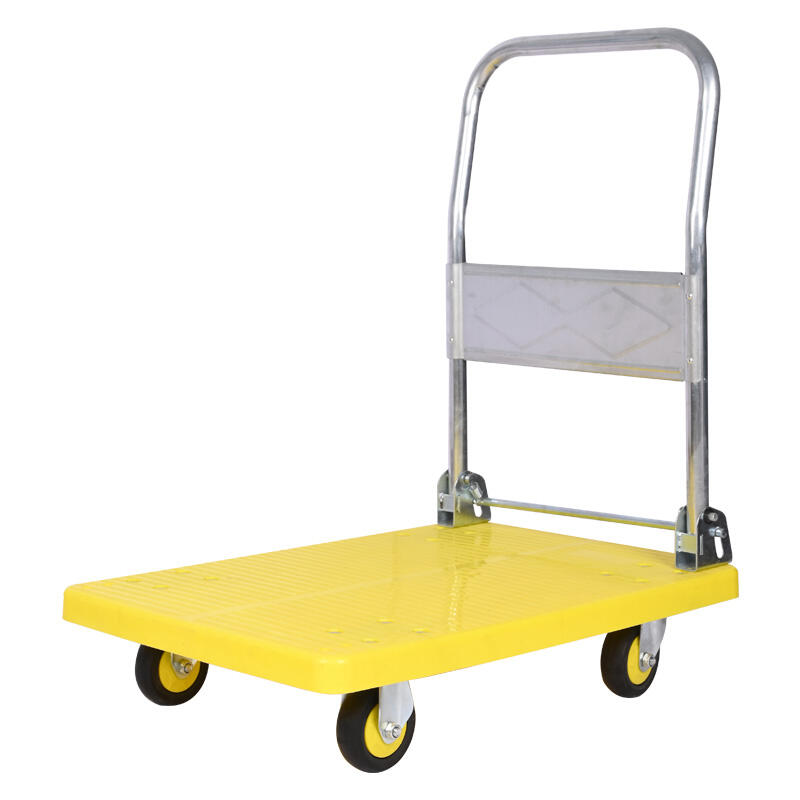In modern industrial and commercial environments, the reliability of material handling equipment directly impacts operational efficiency and long-term cost management. A plastic platform trolley serves as an essential tool for transporting goods across warehouses, retail spaces, and distribution centers. Understanding the factors that contribute to durability in these versatile transport solutions enables businesses to make informed purchasing decisions and maximize their return on investment. The construction quality, material selection, and engineering design all play crucial roles in determining how well these trolleys perform under demanding conditions.
Material Engineering and Construction Quality
High-Density Polyethylene Advantages
The foundation of any durable plastic platform trolley lies in its material composition, with high-density polyethylene (HDPE) emerging as the preferred choice among manufacturers. This thermoplastic polymer offers exceptional resistance to impact damage, chemical exposure, and temperature fluctuations that commonly occur in industrial settings. HDPE maintains its structural integrity even when subjected to repeated loading cycles, preventing the micro-fractures that can compromise cheaper plastic alternatives over time.
Manufacturing processes that incorporate injection molding techniques create uniform density throughout the platform structure, eliminating weak points that might develop with inferior production methods. The molecular structure of properly processed HDPE provides inherent flexibility while maintaining rigidity, allowing the trolley to absorb shock loads without permanent deformation. This balance between strength and adaptability proves essential when transporting heavy or irregularly shaped items across uneven surfaces.
Reinforcement Systems and Load Distribution
Advanced plastic platform trolley designs incorporate strategic reinforcement patterns that distribute weight evenly across the entire surface area. Ribbed undersides and integrated support structures prevent sagging under maximum load conditions while maintaining the lightweight characteristics that make plastic trolleys advantageous over metal alternatives. These reinforcement systems often utilize computer-aided design optimization to identify stress concentration points and strengthen them accordingly.
The integration of load-bearing elements within the plastic matrix creates a composite structure that rivals traditional steel platforms in strength-to-weight ratio. Cross-bracing patterns and honeycomb configurations maximize structural efficiency while minimizing material usage, resulting in cost-effective solutions that deliver superior performance. This engineering approach ensures that the trolley maintains its shape and functionality even after years of continuous use in demanding environments.
Wheel and Bearing System Durability
Precision Bearing Technology
The mobility of any platform trolley depends entirely on the quality and durability of its wheel and bearing systems. Premium plastic platform trolley models feature sealed ball bearings that resist contamination from dust, debris, and moisture commonly encountered in industrial applications. These precision-engineered components reduce rolling resistance while extending operational life through superior lubrication retention and corrosion protection.
Bearing selection directly influences the trolley's ability to maintain smooth operation under varying load conditions. High-grade steel bearings with appropriate raceway tolerances ensure consistent performance while minimizing wear on both the wheel assemblies and the trolley frame. The integration of bearing seals prevents premature failure caused by environmental contaminants, making regular maintenance requirements minimal for end users.
Wheel Material and Tread Design
Wheel construction significantly impacts both durability and operational characteristics of platform trolleys. Polyurethane wheels offer excellent floor protection while providing superior load-bearing capacity compared to standard rubber alternatives. The durometer rating of the wheel material determines its resistance to deformation under load, with harder compounds delivering longer service life at the expense of some shock absorption capability.
Tread patterns engineered for specific applications enhance grip and maneuverability while reducing wear rates on both the wheels and floor surfaces. Non-marking formulations prevent unsightly streaks on clean floors, making these trolleys suitable for retail and healthcare environments where appearance matters. The wheel diameter also affects durability, with larger wheels distributing loads more effectively and rolling over obstacles more easily than smaller alternatives.

Environmental Resistance and Longevity Factors
Chemical and UV Resistance Properties
Industrial environments expose equipment to various chemicals, cleaning agents, and environmental stressors that can degrade inferior materials over time. A well-designed plastic platform trolley incorporates UV stabilizers and chemical-resistant additives that maintain structural integrity despite exposure to harsh conditions. These protective measures prevent brittleness, discoloration, and surface degradation that commonly affect untreated plastic components.
Temperature cycling resistance ensures that trolleys perform reliably in environments with significant temperature variations, from cold storage facilities to heated production areas. The thermal expansion characteristics of properly formulated plastics allow for dimensional changes without creating stress fractures or joint failures. This adaptability extends operational life while maintaining precise tolerances required for smooth operation and load stability.
Corrosion Prevention and Maintenance Requirements
Unlike metal alternatives, plastic platform trolleys offer inherent corrosion resistance that eliminates the need for protective coatings or regular rust prevention treatments. This characteristic proves particularly valuable in wet environments, chemical processing facilities, and outdoor applications where traditional steel trolleys would require frequent maintenance or replacement. The non-porous surface of quality plastics resists bacterial growth and facilitates easy cleaning with standard sanitizing procedures.
Maintenance requirements for durable plastic platform trolleys typically involve simple cleaning procedures and occasional wheel inspection rather than complex lubrication schedules or component replacement. This reduced maintenance burden translates to lower total cost of ownership while ensuring consistent availability for critical material handling operations. The ability to perform basic cleaning with pressure washers or chemical sanitizers makes these trolleys suitable for food service and pharmaceutical applications where hygiene standards are paramount.
Design Features That Enhance Durability
Structural Geometry and Load Management
The geometric design of a plastic platform trolley significantly influences its ability to withstand operational stresses and maintain structural integrity over extended service periods. Curved edges and rounded corners eliminate stress concentration points that could initiate crack propagation under repeated loading conditions. The platform thickness and profile design must balance weight considerations with strength requirements to achieve optimal performance characteristics.
Integrated handle systems and push/pull points distribute user forces across reinforced areas rather than concentrating loads at vulnerable attachment points. Ergonomic considerations in handle design reduce user fatigue while ensuring that applied forces remain within the trolley's design parameters. These thoughtful design elements contribute to both user safety and equipment longevity by preventing overload conditions that might cause premature failure.
Folding Mechanisms and Joint Integrity
For folding platform trolley designs, the durability of hinge mechanisms and locking systems determines long-term reliability and user safety. High-quality plastic trolleys incorporate metal reinforcements at critical pivot points while maintaining overall corrosion resistance through careful material selection and protective treatments. The precision of manufacturing tolerances ensures smooth operation and positive locking engagement throughout the trolley's service life.
Locking mechanisms must withstand repeated cycling while maintaining secure engagement under load conditions. Spring-loaded detents and cam-action locks provide reliable operation with minimal maintenance requirements. The integration of these components with the plastic structure requires careful engineering to prevent stress cracking around attachment points while maintaining the lightweight advantages of plastic construction.
Quality Standards and Testing Protocols
Industry Certification and Compliance
Reputable manufacturers subject their plastic platform trolley products to rigorous testing protocols that verify performance under simulated real-world conditions. Load testing procedures evaluate static and dynamic capacity ratings while fatigue testing assesses long-term durability under repeated loading cycles. These standardized tests provide objective measures of quality and help users select appropriate trolleys for their specific applications.
Compliance with international safety standards ensures that trolleys meet minimum performance requirements for commercial and industrial use. Certification marks from recognized testing organizations provide assurance that products have undergone independent verification of their claimed specifications. This third-party validation becomes particularly important when selecting equipment for safety-critical applications or regulated industries.
Manufacturing Quality Control Systems
Consistent quality in plastic platform trolley production requires comprehensive quality control systems that monitor material properties, dimensional accuracy, and assembly procedures. Statistical process control methods identify variations in manufacturing parameters before they affect product performance. Regular sampling and testing of production batches ensures that material properties remain within specified ranges throughout the manufacturing process.
Advanced manufacturers employ automated inspection systems that detect surface defects, dimensional variations, and assembly errors that might compromise product durability. These quality assurance measures reduce variability between individual units while ensuring that each trolley meets established performance criteria. The implementation of continuous improvement processes based on field performance data further enhances product reliability over successive design generations.
FAQ
How long should a quality plastic platform trolley last under normal use conditions
A well-constructed plastic platform trolley manufactured from high-density polyethylene with quality wheel assemblies should provide 5-10 years of reliable service under normal commercial use conditions. Factors such as load frequency, surface conditions, and environmental exposure significantly influence operational life. Regular cleaning and basic maintenance can extend service life beyond typical expectations, while overloading or abuse will reduce durability regardless of initial quality.
What load capacity should I expect from a durable plastic platform trolley
Durable plastic platform trolleys typically offer load capacities ranging from 150kg to 300kg depending on their size and construction method. The distributed load rating represents the maximum safe working load when weight is evenly spread across the platform surface. Point loads or concentrated weights may require reduced capacity ratings to prevent localized stress concentrations that could cause structural damage over time.
Are plastic platform trolleys suitable for outdoor use and weather exposure
High-quality plastic platform trolleys with UV stabilization and weather-resistant additives perform well in outdoor environments and can withstand regular exposure to rain, snow, and temperature variations. The corrosion resistance of plastic construction eliminates concerns about rust and degradation that affect metal alternatives in wet conditions. However, extreme temperature conditions or prolonged UV exposure without proper additives may affect long-term durability and should be considered during product selection.
What maintenance procedures help maximize plastic platform trolley durability
Maintaining plastic platform trolley durability requires regular cleaning with mild detergents to remove accumulated dirt and debris that could affect wheel operation. Periodic inspection of wheel assemblies for wear or damage helps identify potential issues before they affect performance. Avoiding overloading beyond rated capacity and preventing impact damage from improper handling represents the most effective maintenance approach for extending service life and ensuring reliable operation.
Table of Contents
- Material Engineering and Construction Quality
- Wheel and Bearing System Durability
- Environmental Resistance and Longevity Factors
- Design Features That Enhance Durability
- Quality Standards and Testing Protocols
-
FAQ
- How long should a quality plastic platform trolley last under normal use conditions
- What load capacity should I expect from a durable plastic platform trolley
- Are plastic platform trolleys suitable for outdoor use and weather exposure
- What maintenance procedures help maximize plastic platform trolley durability

